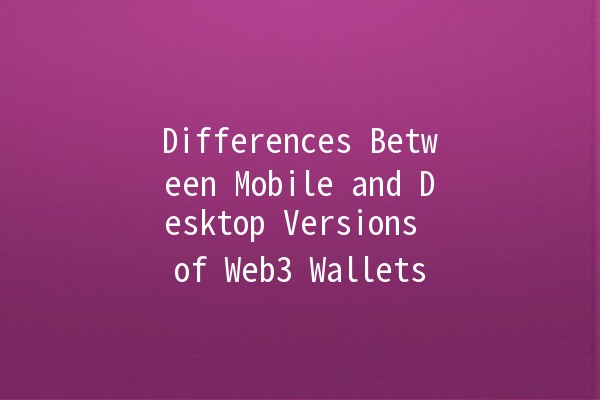




In the rapidly evolving world of blockchain technology, Web3 wallets have become essential tools for managing cryptocurrencies and digital assets. As users navigate through different platforms, they encounter two primary access points: mobile applications and desktop versions. This article delves into the distinctions between these two formats, providing insights that highlight their unique features, advantages, and optimal use cases.
Before diving into the differences, it’s crucial to understand what Web3 wallets are. Simply put, a Web3 wallet is a digital wallet that enables users to send, receive, and store cryptocurrencies securely. It connects users to decentralized applications (DApps) and facilitates transactions on various blockchains.

Mobile Apps: One of the most significant advantages of mobile wallets is their accessibility. With a mobile app, users can manage their digital assets on the go, making transactions or checking balances anytime, anywhere. This is particularly useful for traders or individuals who frequently engage in transactions.
Desktop Versions: While desktop wallets provide similar functionality, they lack the spontaneity offered by mobile applications. They typically require users to be seated at a desk, using a computer, which may not always be practical. However, users might appreciate the large screen for easier navigation and input.
Mobile Apps: Mobile wallets often implement multiple layers of security, such as biometric authentication (fingerprint or facial recognition) and device encryption. These features make it harder for unauthorized users to access the wallet, provided the device itself is secure.
Desktop Versions: Desktop wallets generally have a different security landscape. While they might offer robust security features, including hardware wallet integrations, they are also more vulnerable to malware and phishing attacks, especially if the computer is not adequately protected. Users should ensure that their antivirus software is uptodate and that they regularly scan for threats.
Mobile Apps: The design of mobile wallets is usually optimized for touch interaction and small screens. This can streamline certain tasks, making it easier for users to perform common actions, such as sending or receiving cryptocurrency. Mobile applications often come with notifications that alert users to market changes or pending transactions.
Desktop Versions: In contrast, desktop wallets tend to provide a more expansive interface, allowing for advanced features and detailed information display. This can be beneficial for users who prefer comprehensive insights into their portfolios. However, the complexity might be overwhelming for new users.
Mobile Apps: Mobile wallets typically provide intuitive backup and recovery options, often integrating cloud services for seamless data management. Users can back up their wallets and restore them using seed phrases or recovery phrases.
Desktop Versions: Backup processes on desktop wallets can be a bit more handson. Users might need to manually back up their databases or wallet files and ensure they are stored securely in multiple places. While this offers more control, it can be cumbersome for those unfamiliar with the process.
Mobile Apps: Mobile applications require reliable internet connectivity to function optimally. Users can manage their wallets via WiFi or cellular data, giving them the flexibility to trade on the go. Many mobile wallets also incorporate options for offline transactions, enhancing security.
Desktop Versions: Desktop wallets may operate more efficiently when connected to a stable network, especially for downloading or syncing blockchain data. However, they could be less useful during internet outages unless they support offline capabilities.
Explanation: Opt for Web3 wallets that allow you to sync data across mobile and desktop platforms. This way, you can switch between devices without interrupting your workflow.
Example: If you're using MetaMask on your browser but want to trade crypto on your mobile, ensure that both platforms have the same wallet linked.
Explanation: Always enable 2FA for an added layer of security, particularly when managing significant sums of cryptocurrency.
Example: Authy or Google Authenticator can be employed to generate shortlived codes that make unauthorized logins nearly impossible.
Explanation: Keeping your wallet software updated ensures you benefit from the latest security features and improvements.
Example: Check for updates in your wallet app and desktop software to avoid vulnerabilities associated with outdated versions.
Explanation: Use multiple wallets for different purposes. Consider a hardware wallet for longterm storage and a mobile wallet for everyday transactions.
Example: Store most of your assets in a hardware wallet like Ledger for security, while using a mobile wallet like Trust Wallet for daily transactions.
Explanation: Understanding common threats and how to mitigate them is vital for protecting your assets.
Example: Follow prompts for avoiding phishing scams, such as doublechecking URLs and never sharing your private key.
Mobile Web3 wallets provide unparalleled convenience and accessibility, allowing users to manage their assets anytime and anywhere. They are great for quick transactions and integration with DApps when on the move.
Desktop wallets can offer robust security features, especially when integrated with hardware wallets. However, their vulnerability to malware and the need for constant updates imply that good practices must be followed to ensure security.
Yes, many modern Web3 wallets support crossplatform access, meaning you can create an account on one device and access it on another using the same credentials or seed phrase.
In case of a lost device, you can recover your wallet using your backup seed phrase, provided that you have securely stored it somewhere else. It’s crucial never to store it directly on your mobile device.
Enhancing wallet security involves enabling twofactor authentication (2FA), using strong and unique passwords, regularly updating software, and being aware of phishing tactics.
Most Web3 wallets are free to use, but they may charge transaction fees associated with blockchain operations. Always check the terms and fee structures before selecting a wallet.
Each format of the Web3 wallet has its unique strengths and weaknesses, and understanding these can help users make informed decisions about their asset management strategies. Prioritizing security, convenience, and the context in which they operate will ultimately guide users in selecting the right wallet type for their needs. By integrating practical productivity tips and remaining vigilant about security, users can confidently navigate the diverse landscape of Web3 wallets.